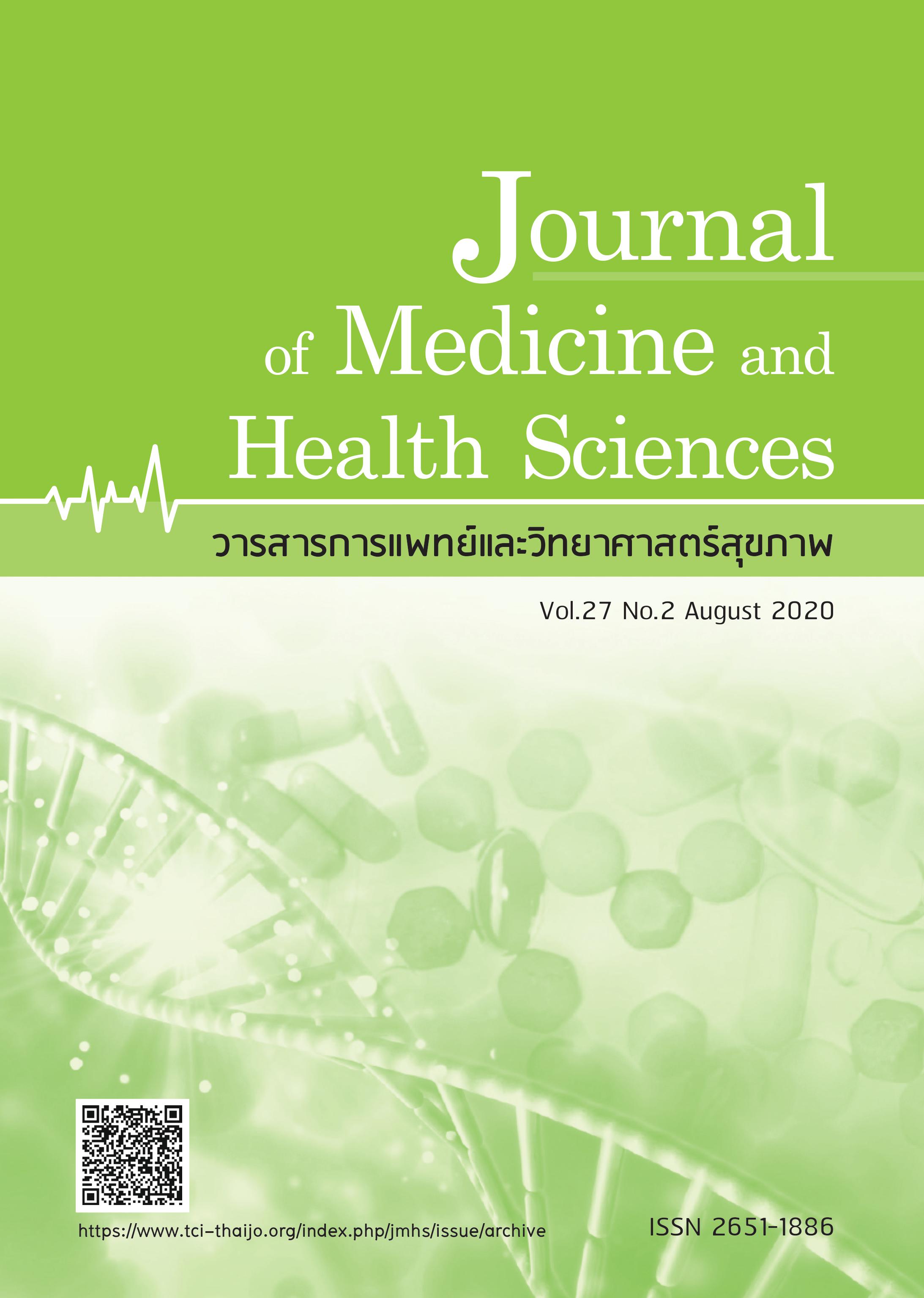ศักยภาพการเป็นพรีไบโอติกและสารต้านอนุมูลอิสระของเฟอรูโลอิลโพลีแซคคาไรด์ที่ได้จาก การย่อยฟางข้าวด้วยรีคอมบิแนนท์เอนไซม์ไซลาเนสของเชื้อ Streptomyces sp. SWU10
คำสำคัญ:
พรีไบโอติก, สารต้านอนุมูลอิสระ, เฟอรูโลอิลโพลีแซคคาไรด, ฟางข้าว, Streptomyces sp. SWU10, ไซลาเนสบทคัดย่อ
พรีไบโอติกและสารต้านอนุมูลอิสระนั้นมีความสำคัญต่อการส่งเสริมสุขภาพ ในการศึกษาครั้งนี้ผลิตภัณฑ์จากการย่อยฟางข้าวที่ไม่ผ่านการปรับสภาพด้วยรีคอมบิแนนท์เอนไซม์ไซลาเนสจาก Streptomyces sp. SWU10 (rXynSW3) ถูกนำมาทดสอบเพื่อหาคุณสมบัติการเป็นพรีไบโอติกและสารต้านอนุมูลอิสระ โดยนำฟางข้าวไปบด ให้เป็นผงแล้วละลายในบัฟเฟอร์ฟอสเฟตที่มีความเป็นกรด-ด่าง เท่ากับ 6.0 จากนั้นทำการย่อยผงฟางข้าวด้วย เอนไซม์ rXynSW3 แล้ววิเคราะห์ผลิตภัณฑ์ที่ได้โดยใช้เครื่อง HPLC และ HPAEC คุณสมบัติการเป็นพรีไบโอติก ถูกประเมินในหลอดทดลอง ด้วยการหมักผลิตภัณฑ์จากการย่อยกับโปรไบโอติก สายพันธุ์ Lactobacillus plantarum F33 และ Bifidobacterium adolescentis JCM1275 และแบคทีเรียก่อโรค สายพันธุ์ Bacteroides vulgatus JCM5826 และ Clostridium hiranonis JCM10541 ความสามารถในการเป็นสารต้านอนุมูลอิสระ ของผลิตภัณฑ์ที่ได้วิเคราะห์โดยใช้วิธี DPPH assay ผลการวิเคราะห์โดยเทคนิค HPLC และ HPAEC พบว่า ผลิตภัณฑ์หลักที่ได้จากการย่อยคือ เฟอรูโลอิลโพลีแซคคาไรด์ (feruloyl-polysaccharide) ผลการต้านอนุมูลอิสระของผลิตภัณฑ์ที่ได้ทั้งหมดโดยวิธี DPPH assay ปรากฏว่าได้ค่า IC50 เท่ากับ 611.10 µg/mL เมื่อเทียบกับ 494.72 µg/mL ของวิตามินซีที่ใช้เป็นสารมาตรฐาน จากการศึกษาคุณสมบัติการเป็นพรีไบโอติกพบว่าผลิตภัณฑ์ที่ได้จากการย่อยสามารถส่งเสริมการเจริญเติบโตของโปรไบโอติกทั้งสองสายพันธุ์ แต่ไม่มีผลต่อ การเจริญเติบโตของแบคทีเรียก่อโรค โดยสรุป จากการศึกษาในหลอดทดลองพบว่า เฟอรูโลอิลโพลีแซคคาไรด์ ผลิตภัณฑ์หลักที่ได้จากการย่อยฟางข้าวที่ไม่ผ่านการปรับสภาพด้วยรีคอมบิแนนท์เอนไซม์ rXynSW3 มีศักยภาพเป็นสารต้านอนุมูลอิสระและพรีไบโอติก
References
lignocellulosic waste: An alternative to
unravel the future bioenergy. Biofuels:
greenhouse gas mitigation and global
warming. 2018:291-305.
2. Kucharska K, Rybarczyk P, Holowacz I, et
al. Pretreatment of lignocellulosic
materials as substrates for fermentation
processes. Molecules 2018;23:2937.
doi:10.3390/molecules23112937.
3. Saini JK, Saini R, Tewari L. Lignocellulosic
agriculture wastes as biomass feedstocks
for second-generation bioethanol
production: concepts and recent
developments. Biotech 2015;5(4):337-53.
4. Taherzadeh MJ, Karimi K. Pretreatment of
lignocellulosic wastes to improve ethanol
and biogas production: A review. Int J Mol
Sci 2008;9(9):1621-51.
5. Day RL, Harpeer AJ, Woods RM, et al.
Probiotics: current landscape and future
horizons. Future Sci OA 2019;5(4):FSO391.
6. Wichienchot S, Thammarutwasik P,
Jongjareonrak A, et al. Extraction and
analysis of prebiotics from selected plants
from southern Thailand. Songklanakarin J
Sci Technol 2011;33(5):517-23.
7. M.T. Holtzapple. Hemicelluloses. Academic
Press 2003:3060-71.
8. Lin SH, Chou LM, Chien YW, et al. Prebiotic
effects of xylooligosaccharides on the
improvement of microbiota balance in
human subjects. Gastroenterol Res Pract
2016:5789232.
9. Jain I, Kumar V, Satyanarayana T.
Xylooligosaccharides: an economical
prebiotic from agroresidues and their
health benefits. Indian J Exp Biol
2015;53(3):131-42.
10. Christensen EG, Licht TR, Leser TD, et al.
Dietary xylo-oligosaccharide stimulates
intestinal bifidobacteria and lactobacilli
but has limited effect on intestinal
integrity rats. BMC Res Notes 2014;7:660.
11. Yu X, Yin J, Li L, et al. Prebiotic potential
of xylooligosaccharides derived from corn
cobs and their in vitro antioxidant activity
when combined with Lactobacillus.
J Microbiol Biotechnol 2015;25(7):1084-92.
12. Geetha K and Gunasekaran P. Purification
of endoxylanase from Bacillus pumilus
B20 for production of prebiotic
xylooligosaccharide syrup; An in vitro
study. Iran J Biotechnol 2017;15(4):232-40.
13. Yang J, Tang Q, Xu L, et al. Combining
of transcriptome and metabolome
analyses for understanding the utilization
and metabolic pathways of Xylooligosaccharide in Bifidobacterium
adolescentis ATCC 15703. Food Sci Nutr
2019;7(11):3480-93.
14. Van de Abbeele P, Marzorati M, Derde M,
et al. Arabinoxylans, inulin and
Lactobacillus reuteri 1063 repress the
adherent-invasive Escherichia coli from
mucus in a mucosa-comprising gut model.
NPJ Biofilms Microbiomes 2016;27(2):16016.
15. Hills RD Jr, Pontefract BA, Mishcon HR, et
al. Gut microbiome: Profound implications
for diet and disease. Nutrients 2019;11(7):
E1613.
16. Modrackova N, Bunesova V, Vlkova E, et
al. Enteral nutrition as a growth medium
for cultivable commensal bacteria and its
effect on their quantity in the stool of
children with Crohn’s disease. J Med Food
2019;22(8):810-6.
17. Nath A, Haktanirlar G, Varga Á, et al.
Biological activities of lactose-derived
prebioltics and symbiotic with probiotics
on gastrointestinal system. Medicina
(Kaunas) 2018;54(2):18.
18. Kho ZY, Lal SK. The human gut
microbiome – A potential controller of
wellness and disease. Front Microbiol
2018;9:1835.
19. Nealon NJ, Yuan L, Yang X, et al. Rice bran
and probiotics alter the porcine large
intestine and serum metabolomes for
protection against human rotavirus
diarrhea. Front Microbiol 2017;8:653.
20. Vitetta L, Vitetta G, Hall S. Immunological
tolerance and function: Associations
between intestinal bacteria, probiotics,
prebiotics, and phages. Front Immunol
2018;9:2240.
21. Azagra-Boronat I, Massot-Cladera M,
Knipping K, et al. Supplementation with
2’-FL and scGOS/FOS ameliorates
rotavirus-induced diarrhea in suckling rats.
Front Cell Infect Microbiol 2018;8:372.
22. Lee HC, Jenner AM, Low CS and Lee YK.
Effect of tea phenolics and their aromatic
fecal bacterial metabolites on intestinal
microbiota. Res Microbiol 2006;157(9):
876-84.
23. Tran THT, Everaert N, Bindelle J. Review
on the effects of potential prebiotics on
controlling intestinal enteropathogens
Salmonella and Escherichia coli in pig
production. J Anim Physiol Anim Nutr (Berl)
2018;102(1):17-32.
24. Tanabe K, Nakamura S, MoriyamaH a s h i g u c h i M , e t a l . D i e t a r y
fructooligosaccharide and glucomannan
alter gut microbiota and improve bone
metabolism in senescence-accelerated
mouse. J Agric Food Chem 2019;67(3):
867-74.
25. Li L, Xiong Q, Zhao J, et al. Inulin-type
fructan intervention restricts the increase
in gut microbiome-generated indole in
patients with peritoneal dialysis: a
randomized crossover study. Am J Clin
Nutr 2020:nqz337.
26. Sukhumsirichat W, Deesukon W, Kawakami
T, et al. Expression and characterization
of recombinant GH11 xylanase from
thermotolerant Streptomyces sp. SWU10.
Appl Biochem Biotechnol 2014;172:
436-46.
27. Hatfield RD, Rancour DM, Marita JM. Grass
cell walls: A story of cross-linking. Front
Plant Sci 2016;7:2056.
28. Florina L, Vodnar DC. Thermal processing
for the release of phenolic compounds
from wheat and oat bran. Biomolecules
2020;10(1):21.
29. Markoviak P, Slizewska K. Effect of
probiotics, prebiotics, and synbiotics on
human health. Nutrients 2017;9(9):21.
30. Chapla D, Pandit P, Shah A. Production of
xylooligosaccharides from corncob xylan
by fungal xylanase and their utilization
by probiotics. Bioresour Technol 2012;115:
215-21.
31. Monteagudo-Mera A, Rastall RA, Gibson
GR, et al. Adhesion mechanisms mediated
by probiotics and prebiotics and their
potential impact on human health. Appl
Microbiol Biotechnol 2019;103(16):6463-72.
32. Mora JA, Montero-Zamora J, Barboza N,
et al. Multi-Producct lactic acid bactria
fermentations: A Review. Fermentation
2020;6(23):6010023.
33. Monteiro CRAV, do Carmo MS, Melo BO,
et al. In vitro antimicrobial activity and
probiotic potential of Bifidobacterium and
Lactobacillus against species of
Clostridium. Nutrients 2019;11(2):448.


